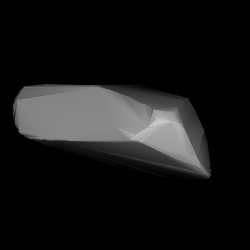1033 Simona, provisional designation 1924 SM, is a stony Eoan asteroid from the outer regions of the asteroid belt, approximately 20 kilometers in diameter. The asteroid was discovered by George Van Biesbroeck in 1924, who named it after his daughter Simona.

1118 Hanskya is a large background asteroid, approximately 77 kilometers in diameter, located in the outer regions of the asteroid belt. Discovered by Sergey Belyavsky and Nikolaj Ivanov in 1927, it was named after Russian astronomer Aleksey Hansky. The presumed dark C-type asteroid has a rotation period of 15.6 hours.
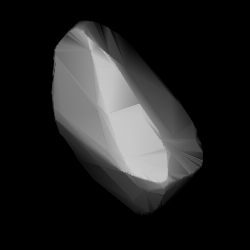
1119 Euboea is a background asteroid from the central region of the asteroid belt. It was discovered on 27 October 1927, by German astronomer Karl Reinmuth at the Heidelberg-Königstuhl State Observatory in southwest Germany. The asteroid has a rotation period of 11.4 hours and measures approximately 30 kilometers in diameter. It was named for the Greek island of Euboea.
1123 Shapleya, provisional designation 1928 ST, is a stony Florian asteroid from the inner regions of the asteroid belt, approximately 11 kilometers in diameter. It was discovered on 21 September 1928, by Russian astronomer Grigory Neujmin at Simeiz Observatory on the Crimean peninsula. It was named after American astronomer Harlow Shapley.
2531 Cambridge, provisional designation 1980 LD, is a stony Eoan asteroid from the outer regions of the asteroid belt, approximately 20 kilometers in diameter. It was discovered on 11 June 1980, by American astronomer Edward Bowell at Lowell's Anderson Mesa Station in Arizona, United States. The asteroid was named for the Cambridge University.
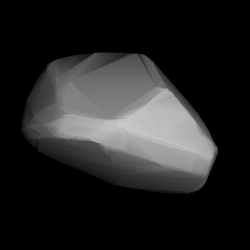
3544 Borodino (prov. designation: 1977 RD4) is a stony background asteroid from the inner regions of the asteroid belt, approximately 9 kilometers (5.6 miles) in diameter. It was discovered on 7 September 1977, by Soviet astronomer Nikolai Chernykh at the Crimean Astrophysical Observatory in Nauchnij, on the Crimean peninsula. The likely elongated S-type asteroid has a rotation period of 5.44 hours. It was named for the Russian village of Borodino where the Battle of Borodino took place.
1411 Brauna, provisional designation 1937 AM, is a stony Eoan asteroid from the outer regions of the asteroid belt, approximately 31 kilometers in diameter. It was discovered on 8 January 1937, by German astronomer Karl Reinmuth at the Heidelberg-Königstuhl State Observatory in Germany. The asteroid was named after Margret Braun, wife of Heidelberg astronomer Heinrich Vogt.
1532 Inari, provisional designation 1938 SM, is a stony Eoan asteroid from the outer regions of the asteroid belt, approximately 28 kilometers in diameter. Discovered by Yrjö Väisälä at Turku Observatory in 1938, it was later named for Lake Inari in northern Finland.
1287 Lorcia, provisional designation 1933 QL, is an Eoan asteroid from the outer regions of the asteroid belt, approximately 22 kilometers in diameter. It was discovered by Belgian astronomer Sylvain Arend at the Royal Observatory of Belgium in Uccle on 25 August 1933. The asteroid was named for Laura de Sołohub Dikyj, wife of Polish astronomer Tadeusz Banachiewicz.
1303 Luthera, provisional designation 1928 FP, is a dark asteroid and the parent body of the Luthera family, located in the outermost regions of the asteroid belt. It measures approximately 90 kilometers in diameter. The asteroid was discovered on 16 March 1928, by astronomer Friedrich Schwassmann at the Bergedorf Observatory in Hamburg, Germany, and later named after German astronomer Robert Luther.
1174 Marmara, provisional designation 1930 UC, is a stony Eoan asteroid from the outer regions of the asteroid belt, approximately 17 kilometers in diameter. It was discovered on 17 October 1930, by German astronomer Karl Reinmuth at Heidelberg Observatory in southwest Germany. The asteroid was later named after the Sea of Marmara, located between Europe and Asia.

1753 Mieke is a stony Eos asteroid from the outer region of the asteroid belt, approximately 20 kilometers in diameter. It was discovered on 10 May 1934, by Dutch astronomer Hendrik van Gent at the Leiden Southern Station, annex to the Johannesburg Observatory in South Africa. The asteroid was named after Mieke Oort, wife of Dutch astronomer Jan Oort.

1364 Safara, incorrectly designated 1935 VB, is an Eoan asteroid from the outer regions of the asteroid belt, approximately 25 kilometers in diameter. It was discovered on 18 November 1935, by French astronomer Louis Boyer at the Algiers Observatory in Algeria, North Africa. The asteroid should have been designated 1935 WB, as the letter "V" only covers discoveries made during 1–15 November. It was named after André Safar, presumably an acquaintance of the discoverer from Algiers.
2091 Sampo, provisional designation 1941 HO, is a stony Eos asteroid and relatively slow rotator from the outer region of the asteroid belt, approximately 30 kilometers in diameter. It was discovered on 26 April 1941, by Finnish astronomer Yrjö Väisälä at Turku Observatory, Finland, and named after Sampo from Finnish mythology.
1760 Sandra, provisional designation 1950 GB, is a carbonaceous asteroid from the outer regions of the asteroid belt, approximately 35 kilometers in diameter. It was discovered on 10 April 1950, by South African astronomer Ernest Johnson at Union Observatory in Johannesburg, and named after his granddaughter Sandra.

1801 Titicaca (prov. designation: 1952 SP1) is a stony Eos asteroid from the asteroid belt, approximately 22 kilometers in diameter. It was discovered on 23 September 1952, by Argentine astronomer Miguel Itzigsohn at La Plata Observatory in the capital of the province of Buenos Aires. It was named after Lake Titicaca in South America.
2443 Tomeileen, provisional designation A906 BJ, is a stony Eoan asteroid from the outer regions of the asteroid belt, approximately 32 kilometers in diameter. It was discovered on 24 January 1906, by German astronomer Max Wolf at the Heidelberg-Königstuhl State Observatory in Heidelberg, Germany. The S-type asteroid was named after the parents of British astronomer Brian G. Marsden. It has a rotation period of 3.97 hours.
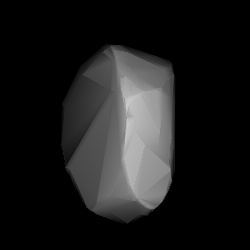
2111 Tselina is a stony Eos asteroid from the outer regions of the asteroid belt. It was discovered on 13 June 1969, by Soviet astronomer Tamara Smirnova at Crimean Astrophysical Observatory in Nauchnij, on the Crimean peninsula. The S-type asteroid has a rotation period of 6.6 hours and measures approximately 23 kilometers in diameter. It was later named after the Soviet Virgin Lands Campaign.
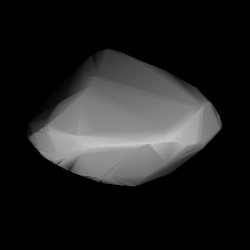
1186 Turnera, provisional designation 1929 PL, is a stony Eoan asteroid from the outer regions of the asteroid belt, approximately 36 kilometers in diameter. It was discovered on 1 August 1929, by South African astronomer Cyril Jackson at the Union Observatory in Johannesburg. The asteroid was later named after British astronomer Herbert Hall Turner.

5357 Sekiguchi is an Eos asteroid from the outer region of the asteroid belt, approximately 15 kilometers in diameter. It was discovered on 2 March 1992, by Japanese amateur astronomers Tetsuya Fujii and Kazuro Watanabe at the Kitami Observatory in eastern Hokkaidō, Japan. The asteroid was later named after Japanese astronomer Tomohiko Sekiguch.
